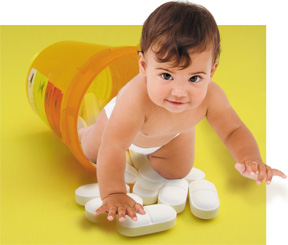Additionally, the researchers at Medco believe the obesity epidemic could be to blame for the greatest spike in prescriptions over the nine-year span considered in the report. There was a 147 percent increase in the number of children prescribed proton-pump inhibitors, which are treatments for heartburn and gastroesophageal reflux disease (GERD).
The report noted, "The increases in prescription drug use by children for chronic conditions could fuel significantly higher health care costs as those young patients enter adulthood." However, perhaps the bigger concern should be that many of these drugs have not been tested and no research exists to tell parents what can happen when they are taken regularly from childhood into adulthood.
Growing Concern
The Medco report also indicated that medication use for attention deficit hyperactivity disorder (ADHD) is on the rise, with 13.2 percent of the prescription drug benefit dollars spent in this area. However, the greatest concern could be the spike in use of atypical antipsychotics. Traditionally used to treat schizophrenia, these drugs recently have been prescribed to children for a variety of psychiatric disorders.
 "Atypical antipsychotics are extremely powerful drugs that are being used far too commonly - especially in children - given their safety issues and side effects," says Dr. David Musina, a specialist in mood disorders and national practice leader of the Medco Therapeutic Resource Center for Neuroscience. He further notes that they are being prescribed for depression and anxiety, "for which there is not good evidence that they are an effective treatment and yet we're exposing children to the possibility of extreme weight gain that could lead to a host of health problems, including diabetes."
"Atypical antipsychotics are extremely powerful drugs that are being used far too commonly - especially in children - given their safety issues and side effects," says Dr. David Musina, a specialist in mood disorders and national practice leader of the Medco Therapeutic Resource Center for Neuroscience. He further notes that they are being prescribed for depression and anxiety, "for which there is not good evidence that they are an effective treatment and yet we're exposing children to the possibility of extreme weight gain that could lead to a host of health problems, including diabetes."
Medco also noted in its report that since the FDA issued a suicide warning in 2004 for certain antidepressants, there has been a 23 percent drop in children taking these pharmaceuticals. However, the FDA has expanded to pediatric patients the indications for many new atypical antipsychotic medications, including Abilify, Zyprexa and Seroquel, which has the listed side effects of "signs of diabetes" and "large or rapid weight gain."
A Worldwide Problem
As with most trends in the United States, other countries like Canada, the United Kingdom and Australia tend to follow suit. For instance, despite the guidelines set forth by the National Institute for Health and Clinical Excellence, the number of prescriptions written in the U.K. for Ritalin is up 33 percent and in Canada, the use of ADHD drugs increased almost 50 percent between 1999 and 2004, according to IMS Health Canada. Although no current figures are available, there are very real concerns regarding the continued increase in the number of prescription drugs being given to Canadian children.
 Implicating Big Pharma
Implicating Big Pharma
The National Center for Health Statistics reports that the percentage of Americans taking at least one prescription drug each month increased from 44 percent to 48 percent from 1999 to 2008. The percentage taking two or more increased from 25 percent in 1999 to 31 percent in 2008. In that same time period, the percentage of Americans who took five or more prescription drugs per month increased from 6 percent to 11 percent. Is it any wonder that in the United States alone, almost $300 billion is spent each year on pharmaceuticals?
In researching this article, I was not able to determine what portion of the dollars spent annually on prescription drugs is spent on prescriptions for children, although a Medco study in 2002 reported that spending on prescription drugs for those under age 19 grew 28 percent in 2001. Yet, despite not knowing exactly how much Americans are spending to drug their children, we do know that the pharmaceutical industry spent $189 million last year alone just lobbying Congress and other important law-makers to pass legislation that has allowed for more advertising and more drugs available on the market.

